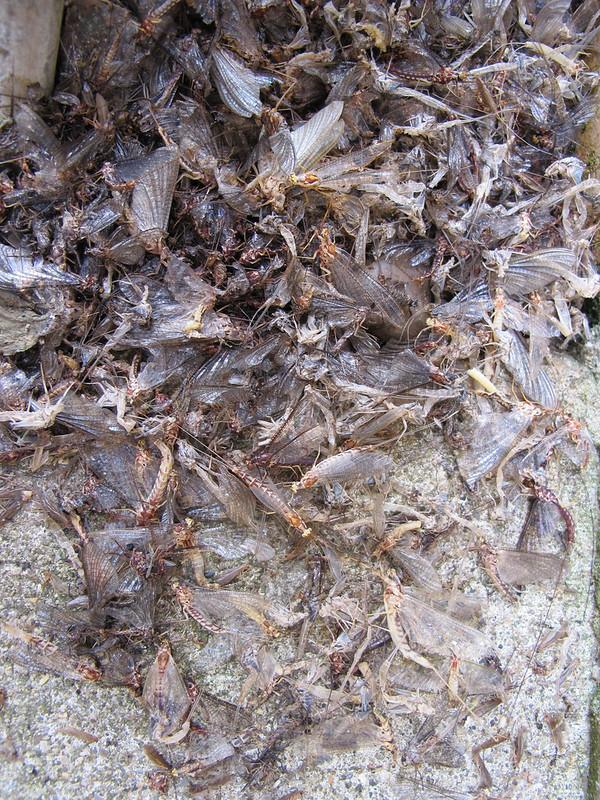When will the mayflies arrive?
Temperature, wind and other environmental factors control the timing and number of mayflies that reach the shores of Lake Erie and Lake St. Clair.

In early summer along the western shores of Lake Erie and Lake St. Clair many people wonder, when will the mayflies (also known as fish flies) arrive and how many will there be this year?
First, a few key facts about mayflies. Mayflies are aquatic insects that live most of their lives in the water. Mayflies overwinter in sediments at the bottom of lakes and streams. Pollution and lack of oxygen in bottom sediments killed off Lake Erie’s mayflies in the early 1950s, and they remained rare for forty years. Mayfly populations began to rebound in the early 1990s and reached their density management goal 1997, which means there are enough to support other species.

Mayflies are an important food for birds and fish such as yellow perch. The presence of mayflies is considered an indicator of good water quality. Mayflies emerge from the water so that they can mate and lay eggs on the water surface. The eggs will later fall into the bottom sediments. Find out more online about the mayfly lifecycle and how you can reduce the number appearing in your backyard.
What controls the timing of mayfly emergence?
The timing of mayfly emergence from sediments is based on the water temperature. Mayflies emerge after the water temperature at depth reaches 20 degrees Celsius (68 degrees Fahrenheit). In the western Lake Erie basin and Lake St. Clair, water is shallow enough that the water temperature at the surface is only a few degrees different from the temperature at depth.
How do I know what the water temperature is in Lake Erie or Lake St. Clair?
You can monitor the surface water temperature via buoys. A few days after buoys indicate a temperature of 20 degrees Celsius, the sediments will also warm to that temperature and mayflies will start to emerge. The National Oceanic and Atmospheric Administration has an experimental forecast product for bottom water depths that is frequently updated. You can also view current temperatures on the Seagull platform, part of the Great Lakes Observing System. This way you can tell in real-time when mayflies will begin to emerge.
If mayflies only live outside of water for two days, why does the mayfly “season” continue for several months (typically June through August)?
Scientists do not understand why mayflies persist so long. Mayflies emerge in different cohorts. One cohort has gone through several growth stages and is almost ready to emerge in late summer or fall but is prevented by the declining temperatures. These are the first cohorts to emerge the following summer. Individuals in the second cohort are smaller in the fall and are not ready to emerge until later in the following summer. There are also two similar but separate species of mayflies in Lake Erie and they may develop at slightly different rates.
Can you predict how many mayflies will emerge this year?
It is hard to predict how many mayflies will emerge because there are a number of environmental factors that control the number of mayflies. These factors include the number of mayflies that survive the winter as well as the oxygen levels at depth in Lake Erie. A harsh winter may mean fewer mayflies survive. Low oxygen conditions at depth can also suffocate the mayfly larvae in the sediments.
How many mayflies will reach my backyard?
Not all mayflies that emerge will reach land. Mayflies may land on islands instead. Wind speed and direction impacts whether mayflies from the Canadian side of Lake Erie end up on land in the United States or vice versa. Mayfly swarms are expected within a few days of water temperatures reaching 20 degrees Celsius and may continue up to 10 days (Corkum et al., 2006). In many cases, swarms are large enough to appear on weather radar at this time.
When you see mayflies, remember they are a sign of healthy local water bodies and that the mayflies are providing food for birds and fish you like to watch or catch!
Michigan Sea Grant helps to foster economic growth and protect Michigan’s coastal, Great Lakes resources through education, research and outreach. A collaborative effort of the University of Michigan and Michigan State University and its MSU Extension, Michigan Sea Grant is part of the NOAA-National Sea Grant network of 34 university-based programs.
Citation: Corkum, L.D., Ciborowski, J. J. H., and Dolan, D. M. 2006. Timing of Hexagenia (Ephemeridae: Ephemeroptera) mayfly swarms: Canadian Journal of Zoology v. 84 n. 11, pg. 1616-1622.
This article was prepared by Michigan Sea Grant under award NA22OAR4170084 from the National Oceanic and Atmospheric Administration, U.S. Department of Commerce through the Regents of the University of Michigan. The statement, findings, conclusions, and recommendations are those of the author(s) and do not necessarily reflect the views of the National Oceanic and Atmospheric Administration, the Department of Commerce, or the Regents of the University of Michigan.



 Print
Print Email
Email

